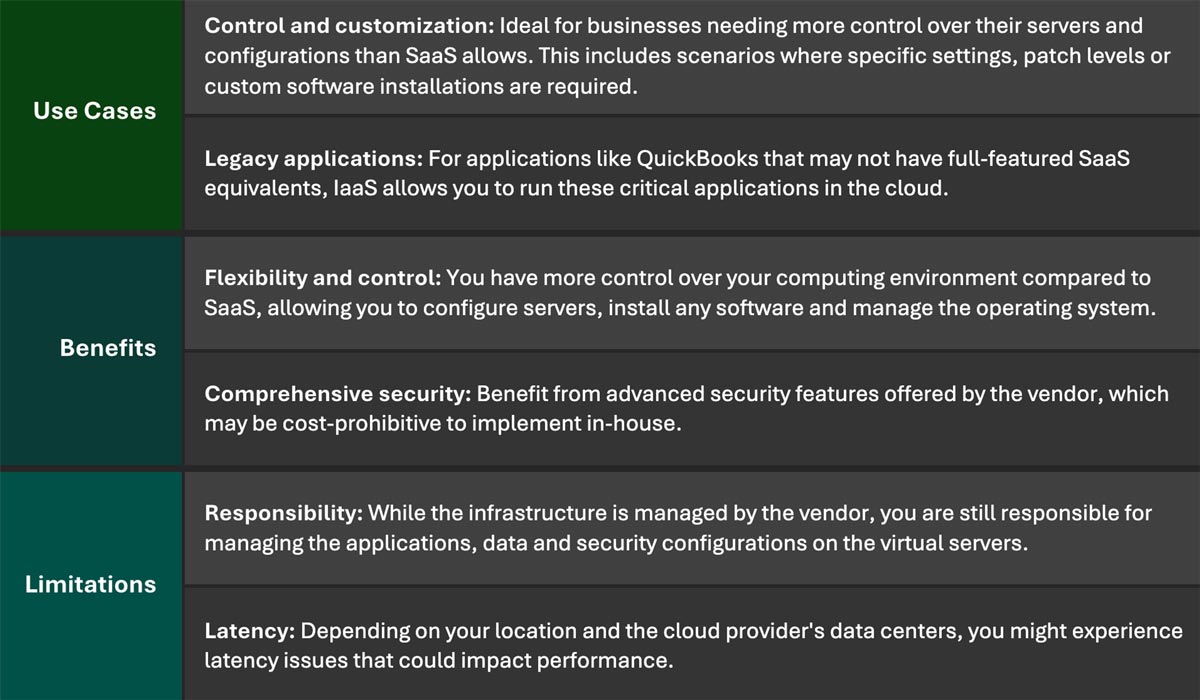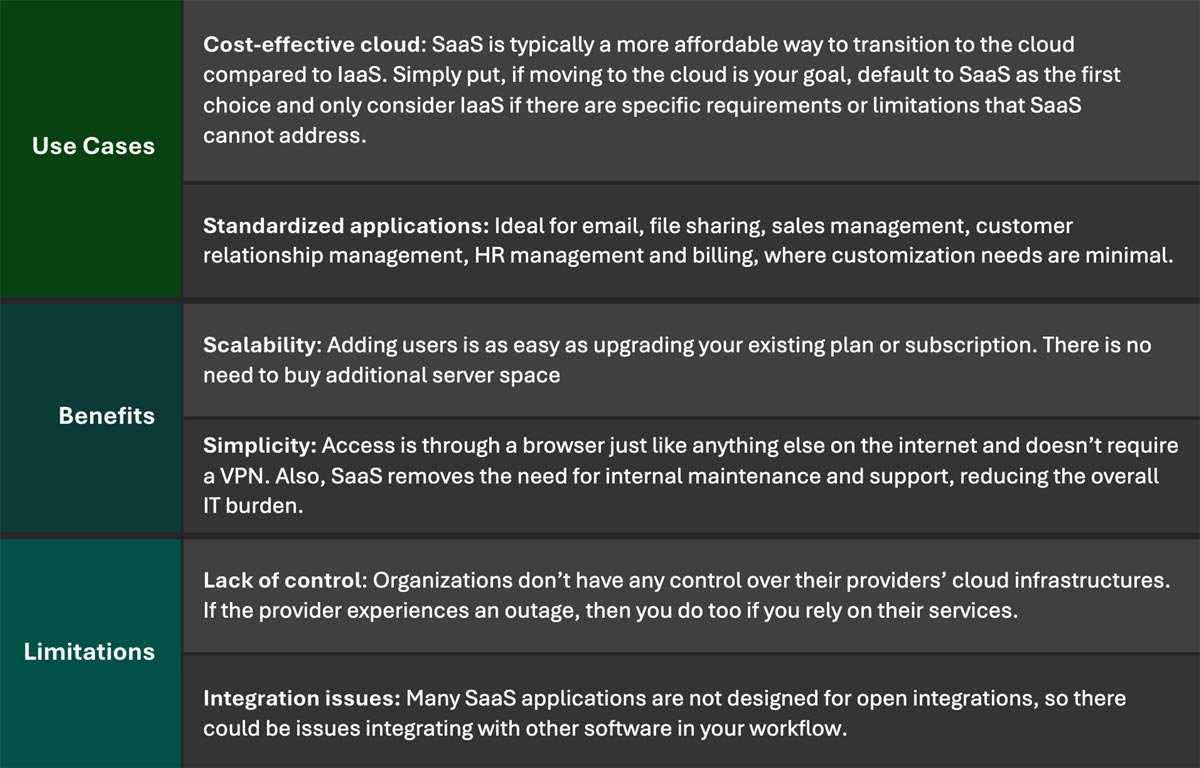Contributed by: Hungerford Technology
As businesses move from on-premises servers to cloud-based environments, choosing between Infrastructure as a Service (IaaS) and Software as a Service (SaaS) is crucial. This article compares these two options, outlining their benefits and limitations to help you make informed decisions. Whether adopting one or both, this guide supports your transition to a more flexible and cost-effective cloud solution.
IaaS vs. SaaS: Your Guide to Moving to a Serverless Environment
As businesses look to modernize their IT infrastructure, moving from on-premises servers to a cloud-based, “serverless” environment is a major step. Two popular options to consider in this transition are Software as a Service (SaaS) and Infrastructure as a Service (IaaS).
Understanding these options, along with their benefits and limitations, will help you make informed decisions that align with your business needs.
It is important to note, however, that SaaS and IaaS are not mutually exclusive. Many small and medium-sized businesses use both.
How IaaS and SaaS Compare to On-premises Servers
When considering the transition from on-premises servers to cloud-based solutions, it’s important to understand the similarities between the two cloud options compared to traditional on-premises setups:
- Reduced hardware costs: With both cloud options, there’s no need to invest in and maintain expensive physical hardware on-site. Both models shift the hardware burden to the service provider, which can significantly reduce capital expenditures and ongoing maintenance costs.
- Remote access: The cloud options allow your employees to access applications and data from anywhere, enhancing flexibility and supporting a more distributed workforce. It should be noted that IaaS likely still will require a VPN to access, whereas SaaS would eliminate the need for a VPN.
- Improved security and compliance: Both IaaS and SaaS vendors typically offer robust security measures and compliance certifications. This means you benefit from high levels of security and compliance without needing to implement these measures yourself, which can be complex and costly with on-premises servers.
- Predictable costs: Cloud services operate on a subscription-based pricing model, offering predictable monthly or annual costs. This contrasts with the often less predictable costs associated with maintaining and upgrading on-premises servers.
By understanding these similarities, businesses can better appreciate the advantages of transitioning to cloud-based solutions: enhanced flexibility, reduced costs and improved efficiency over traditional on-premises servers.
“Ultimately, IaaS offers more control, but SaaS offers easy access and less responsibility. Each also comes with limitations, so it’s important to speak with your IT team or managed service provider about the pros and cons of each solution.”
Why Would You Use IaaS or SaaS?
As stated earlier, there is no rule that says you have to use one or the other. An organization might utilize SharePoint for file sharing rather than having an on-premises server, but maybe that same organization has line-of-business applications that must be hosted on a virtual server.
More About Infrastructure as a Service (IaaS)
You can think of IaaS as renting a car from a rental company. While it offers more flexibility and removes the burden of maintenance, you are still responsible for filling the gas tank and driving the car.
IaaS is a cloud-based alternative to on-premises infrastructure. The IaaS cloud vendor hosts the infrastructure components — such as servers, storage and networking hardware — that would typically physically exist within your organization.
Examples include:
- Microsoft Azure
- Amazon Web Services (AWS)
- Google Cloud Platform (GCP)
Instead of a physical server at your organization’s location, with IaaS, you pay a monthly subscription fee to utilize a virtual server running on the vendor’s hardware. And unlike SaaS, you have way more control over your computing infrastructure.
Decision Factors for Infrastructure as a Service (IaaS)

More About Software as a Service (SaaS)
You can think of SaaS applications like Uber: You don’t own or rent the car and you don’t drive the car, but you pay a fee to use the car. The use of SaaS applications is similar: You don’t own the application and have limited control over how it’s configured, but you pay a fee to use the service (usually monthly with SaaS applications).
The SaaS provider handles the maintenance and support of the applications, just like you aren’t expected to pay for the maintenance of the Uber car.
Examples include:
- Salesforce or HubSpot
- Entra ID for user and device management
- SharePoint and OneDrive for file sharing
- Line-of-business applications like QuickBooks Online
With SaaS, you can access your applications from anywhere with an internet connection without worrying about the underlying infrastructure. This model is particularly beneficial for standardized applications where customization needs are minimal.
Decision Factors for Software as a Service (SaaS)

Want to Discuss Your Options?
Ultimately, IaaS offers more control, but SaaS offers easy access and less responsibility. Each also comes with limitations, so it’s important to speak with your IT team or managed service provider about the pros and cons of each solution.
Ready to move to the cloud and stop talking about server hardware? Contact Hungerford Technology here to see how they can help keep your business running smoothly while increasing productivity, security and profitability.
Contributed by:

2910 Lucerne Drive SE
Grand Rapids, MI 49546
United States
Hungerford
Email: support@hungerford.tech
Phone: (616) 949-4020




